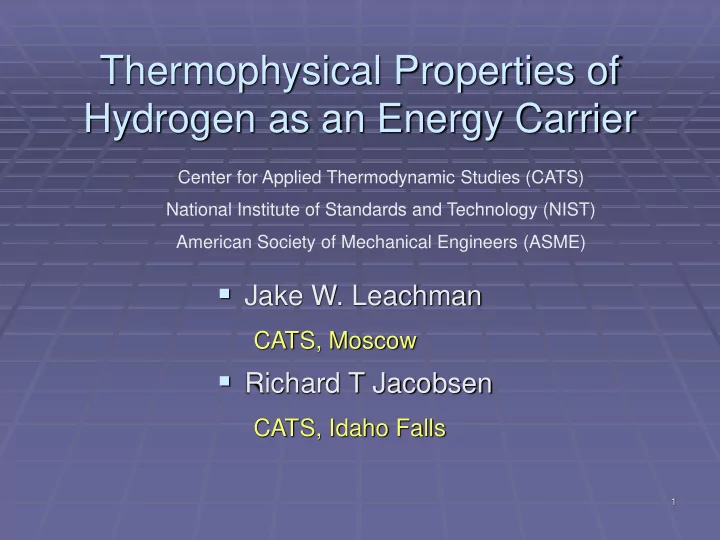

Thermophysical Properties of Hydrogen as an Energy Carrier Center for Applied Thermodynamic Studies (CATS) National Institute of Standards and Technology (NIST) American Society of Mechanical Engineers (ASME) ▪ Jake W. Leachman CATS, Moscow ▪ Richard T Jacobsen CATS, Idaho Falls 1
Presentation Outline ▪ Our energy future ▪ Hydrogen production, storage, and use ▪ Role of thermophysical properties in design ▪ Status of current property data and formulations ▪ Future research 2
Our Energy Future ▪ World energy demand increasing in China, India and other developing countries ▪ Middle Eastern countries controlling the supply of oil ▪ Gasoline prices at the pump -- $3.00 per gallon or more ▪ President Bush’s 2003 Hydrogen Fuel Initiative ▪ $289.5 million requested for FY 2007 3
Hydrogen Implementation ▪ Vancouver Hydrogen highway infrastructure ▪ In operation by 2010 Winter Olympics 4
Hydrogen Implementation ▪ California Hydrogen highway infrastructure ▪ 13 existing stations ▪ 170 stations in operation by 2010 ▪ Over 60 cars in operation 5
What’s Hydrogen? ▪ Most abundant element in the Universe ▪ 75% of all mass, 90% of all atoms ▪ Colorless, odorless, tasteless gas ▪ Diatomic molecule ▪ An energy carrier or fuel ▪ Does not exist in pure form on earth 6
The Hydrogen Supply Storage and Sale and Generation Usage Distribution ▪ Fossil Fuels ▪ Compressed gas ▪ Internal Combustion ▪ Electrolysis ▪ Cryogenic liquid ▪ Fuel Cells ▪ Nuclear ▪ Slush ▪ Biological ▪ Absorbed ▪ Thermo-chemical 7
Supplier and Consumer Questions ▪ Safety? ▪ Efficiency? ▪ Costs of buying and selling? ▪ Answer: Well designed systems. 8
Design of Hydrogen Systems ▪ Require accurate properties of hydrogen ▪ Custom experimental measurements not practical ▪ All thermodynamic properties from an Equation of State (EOS) ▪ All transport properties from a separate formulation ▪ EOS and transport formulations model published experimental data 9
EOS Formulation ▪ EOS are created by fitting experimental data ▪ Data maps show existing experimental data ▪ Temperature scales must be updated ▪ Equations are limited by the range and accuracy of experimental data 10 Normal Hydrogen Data Map P-v-T
EOS Formulation ▪ Deviation plots compare EOS to experimental data ▪ Deviations represent flaws in the EOS ▪ Uncertainty based on EOS deviations from experimental data % deviation in density = 100*( ρ data - ρ calc )/ ρ data 11 Normal Hydrogen Deviation Plot
Standard Hydrogen EOS Accuracies ▪ Hydrogen standard EOS from 1982 ▪ Methane standard EOS from 1991 has better accuracies Estimat imated ed Uncert rtainty ainty in Normal l Hydrogen ogen and Methane ane EOS Proper perty ty Liquid uid H 2 Vapor por H 2 Super percriti itical al H 2 Methane ane Density 0.1% 0.25% 0.2% 0.03-0.07% Heat Capacity 3% 3% 3% <1% Speed of Sound 2% 1% 1% 0.03-0.3% Viscosity 4-15% 4-15% 4-15% 0.5-2% Thermal Conductivity 1-10% 1-10% 1-10% 2-10% 12
Importance of Accuracy ▪ U.S. used 440 million gallons of gasoline daily in 2004 ▪ 1 gallon of gasoline ≈ 1 kg of hydrogen ▪ Gasoline $2.50 per gallon and fluctuating ▪ 0.2% uncertainty in density calculation ▪ $2.2 million discrepancy in gross product sale every day ( )*$2.50 = $1.1 billion 440 million kg hydrogen gallons gasoline ($1.1 billion)*(.002) = $2.2 million discrepancy 13
Standard Hydrogen EOS Limits ▪ Upper temperature limit of 400 K 14
Hydrogen: 2 different molecules Molecular Hydrogen – H 2 Normal 3 : 1 parahydrogen orthohydrogen lower energy state higher energy state can exist in pure form cannot exist in pure form 15
Equilibrium Hydrogen ▪ Percentage of parahydrogen in equilibrium mixture ▪ Predicted by quantum mechanics and statistics 16
Modeling the Hydrogen Forms ▪ The different forms have different thermophysical properties ▪ Ideal gas behavior predicts differences ▪ Two different EOS exist ▪ Parahydrogen EOS (pure fluid) ▪ Normal hydrogen EOS (treats normal hydrogen mixture as pure fluid) ▪ No mixture EOS exists for parahydrogen and orthohydrogen 17
Storage Behavior ▪ Conversion between forms causes energy change ▪ Energy change greater than the latent heat of vaporization 18
CATS Research ▪ Survey of published hydrogen properties ▪ Over 200 hydrogen property papers identified ▪ Status of standard formulations for both thermodynamic and transport properties ▪ An orthohydrogen EOS ▪ Mix orthohydrogen with parahydrogen ▪ Updated property formulations 19
Conclusions ▪ Accuracy of hydrogen EOS must be increased ▪ New hydrogen EOS must be accurate at high and cryogenic temperatures ▪ Hydrogen mixture EOS must be created 20
Questions? Source: General Motors Corporation 21
Recommend
More recommend